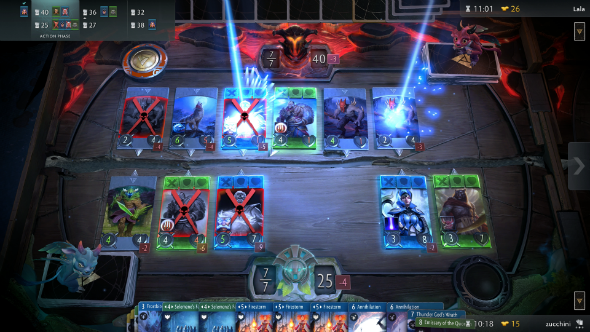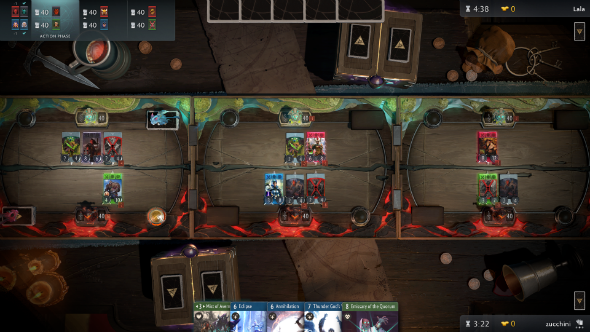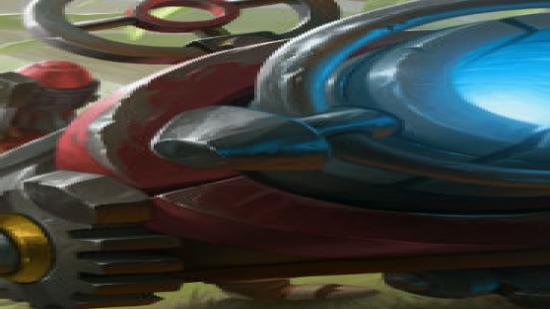The announcement of Artifact at last year’s Dota 2 International was met with a mixed response. That circumspection was unwarranted. Valve’s card game, despite following a few years behind Blizzard and CD Projekt Red’s high-profile efforts, is more ambitious, expansive, and inventive than anything that has come before.
Here’s our freshly-updated look at everything we know about Artifact’s gameplay, cards, and heroes.
Developed within the Dota 2 universe, Artifact has some obvious parallels with Valve’s MOBA. Artifact is played simultaneously across three boards, representing Dota 2’s top, middle, and bottom lanes. Each board is populated with heroes and creeps, which aim to destroy the enemy towers, one of which is located at the back of each of your three boards, and acts as your health bar – if it hits zero, you have lost that lane. If two towers fall on your side of the board, it’s game over. If they so choose, however, you opponent can continue to focus their efforts on a particular lane even after the tower has fallen as, if a structure falls, it is replaced by an Ancient – which act as Dota 2’s bases. These spawn at twice the health count of a tower – 80, rather than 40 – but the game ends automatically if it is destroyed.
For the most part, each board is separate entity. Once creeps and your five heroes have been assigned to lanes, they attack automatically, hitting enemies either directly or diagonally in front of them, based on chance. If there is nothing in the way, they will hit the enemy tower, dealing damage to it based on their attack value. If they hit an obstacle, they will deal and take damage, and if their health reaches zero, they leave the board. Creeps are taken out of play, while heroes ‘respawn’ after a turn.
When an enemy unit dies, you are granted gold – five for a hero, one for a creep – that can be spent on items during the shopping phase that occurs after every full rotation through the top, middle, and bottom lanes. Items offer either bonus health, attack damage, or armor, all of which correspond to a slot on your heroes’ cards. If a hero dies, it maintains its items, and any bonus stats you have given it. Many items also have bonus effects, so while a Short Sword will give your hero two extra attack damage, a Blink Dagger will allow them to swap to a new lane, either to get out of trouble or block an incoming attack.

Heroes come in one of four different suits, from Red ‘bruiser’ heroes like Axe, who sacrifice tactical complexity for brute strength, to magelike Blue cards, such as Zeus, who lack strength in the early game but become much more powerful later on. Each suit also contains spells, which can only be played in a lane with a corresponding hero – a green card can only be played on a board with a green hero, for example.
This is where it starts getting more complicated, as while heroes and creeps may mean that lanes remain separate in their attack patterns, items and spells mean that you are soon having to balance your strategy across three different matches – no doubt the influence of Magic: the Gathering creator Richard Garfield, who joined Valve to work on the game. In this sense, Artifact gains a level of depth that puts it far ahead of its competitors; in Hearthstone, while playing a card at the right time is important, there are very few cards that rely on position to be most effective; in Gwent, timing is less crucial, but where you play a card has more importance.
In Artifact, not only are you playing across three boards at once, you are carrying spells and items from board to board. Items can be used anywhere, but spells have to be used in conjunction with certain heroes, meaning that although you might want to use a particular hero as a sponge to soak up damage, doing so could easily mean not getting to use the spell you want. A mana system is present, unique to each lane, so while your mid lane might have seven mana thanks to a passive boost, top and bottom might only have five, limiting the cards you can play there. There is also gold to consider – do you buy the cheap items for a small advantage now, or save up for next time around and potentially suffer the consequences?

The strategies this could open up are enormous, but while the mechanical depth is to be commended, I am concerned that the overall complexity could put off players unfamiliar with card games – which Artifact will likely attract given its proximity to such a different genre. A generous economy, which Valve say will reward players for a wide variety of playstyles, from theory-crafters to RNG-enthusiasts, will hopefully do something to alleviate that issue.
If Artifact is to be praised for its tactical breadth and depth, it should also be commended for its beautiful UI. There is some of the humour and light-heartedness of Hearthstone, most keenly expressed by mischevious goblins who escort you and your deck from lane to lane, combined with the rustic minimalism of Gwent. Card art, in particular, is almost uniformly outstanding, and there are some mind-bogglingly well-produced effects – the best of these stems from Zeus’ Thundergod’s Wrath, which skims above each board, blasting cards out of existence. A particularly nice touch comes from the references to Dota 2’s map – the Dire and Radiant are both expressed, but I also really enjoyed the river running down the centre of each board.
Artifact is yet to be truly put through its paces – no amount of in-house balancing and testing can replicate a community – which will undoubtedly number in the millions – digging into the game on full release. But I have a sense that Valve’s attempt at a trading card game is a real departure from the CCGs that have dominated the digital landscape in the past few years. Its complexity will prove a stumbling block for some, but I’d rather struggle with a game for its difficulty rather than its prohibitive expense. Beyond the simply material however, Artifact offers a game that is a cut above other card games I have played. It successfully captures elements from two wildly different genres, creating something that I am hugely excited to return to. If this truly does herald the start of a new era of Valve games, as Gabe Newell suggested during the game’s press event, Artifact is a monumental place to start.
